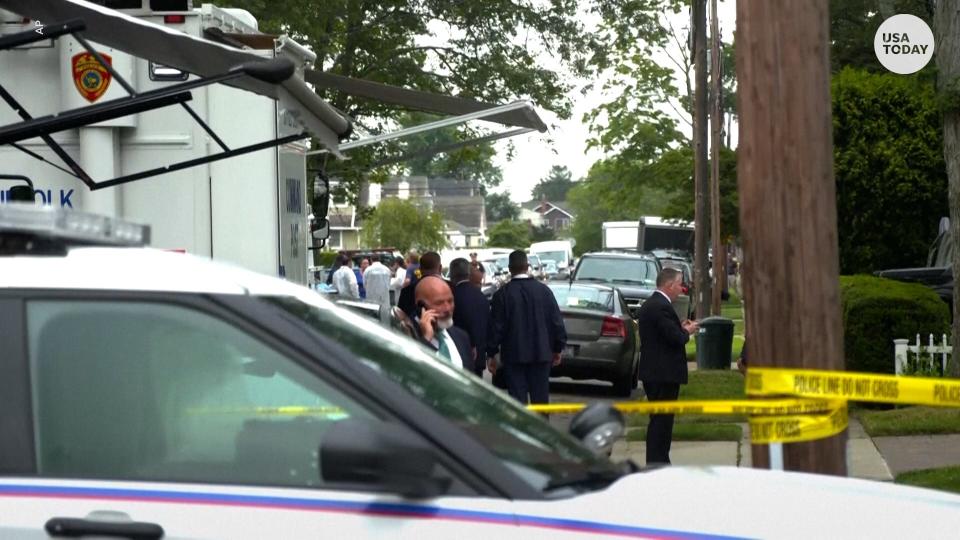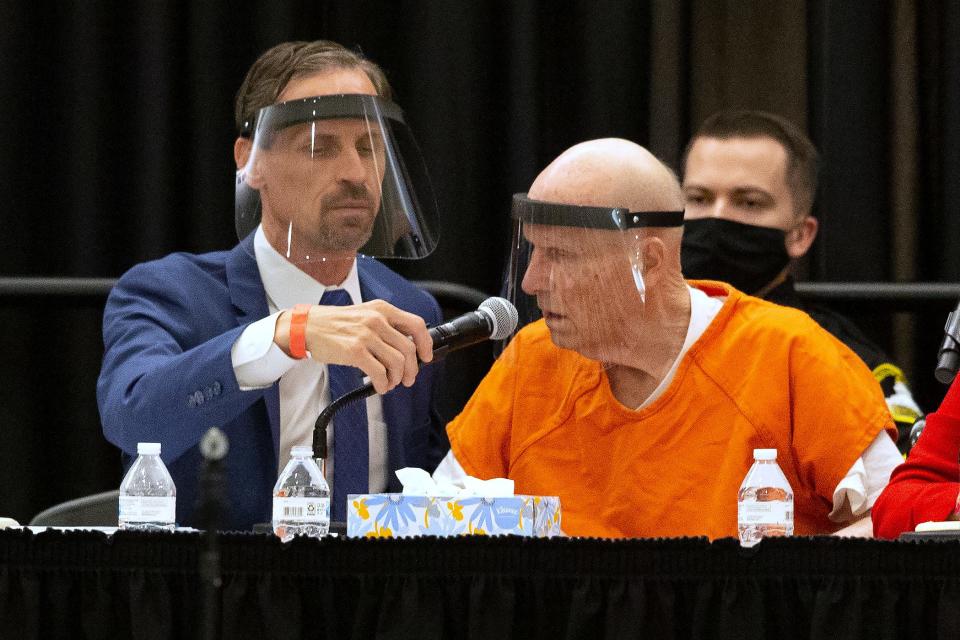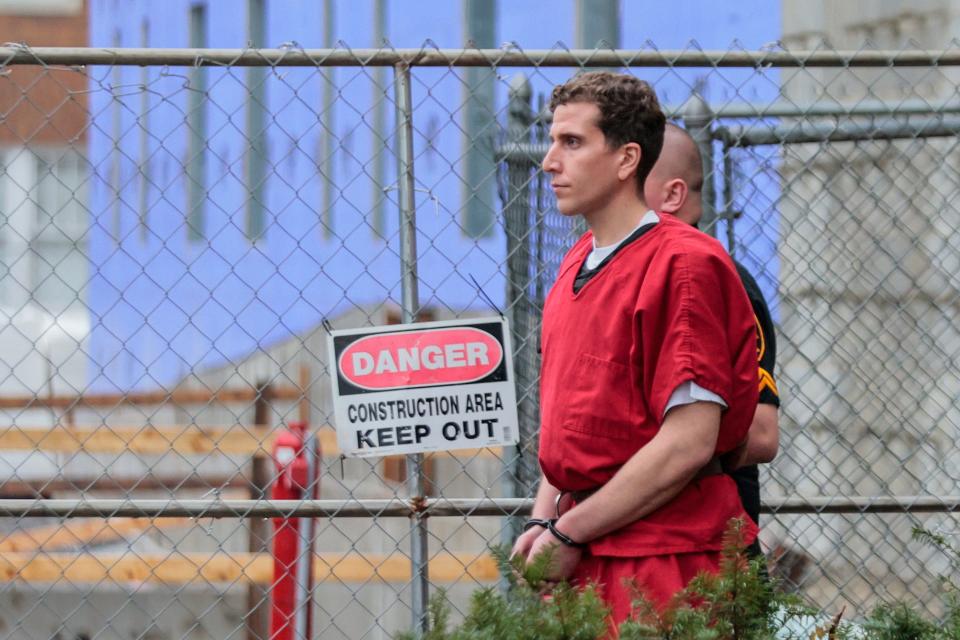Discarded DNA: The controversial clue in the trash that's bringing serial killers to justice
- Oops!Something went wrong.Please try again later.
The Long Island Gilgo Beach murder case is one of many in recent years when a long-unsolved homicide got a break from an unlikely source: discarded DNA.
In the case of the more than a decade-old murders of three female sex workers, it was pizza crust in a Manhattan trash can that last week landed Rex Heuermann in jail, charged in killings that had stumped detectives who trying to find a killer who seemingly left no meaningful clues.
Police had discovered DNA on the bodies but couldn't match it to anyone. Until Heuermann threw their much-needed clue into the trash − and their lap.
Police didn’t need a court order or a warrant to grab the DNA from public property. They took the food remains that Heuermann trashed in a pizza box without his knowledge and matched it to DNA found on a piece of hair from one of the murder victims. Suffolk County District Attorney Raymond Tierney called it a "watershed event" in the mystery.
The case illuminates a tactic that is a growingly important weapon in the arsenal of police detectives across the nation: grabbing publicly available, private DNA – off abandoned food, soda cans, car doors, even cigarette butts – that belongs to suspected killers.
The process is called "surreptitious DNA collection."
USA TODAY talked to forensic science experts about the DNA strategy authorities are using and its efficacy and practice. They said the process is common and a helpful tool that can help authorities pin down those who they are already suspicious of to connect them to a dangerous crime.
"It works under the premise that you no longer have an expectation of privacy in things that you discard. It's abandoned DNA," said Peter Valentin, a department chair of forensic science at the University of New Haven and a former detective with the Connecticut State Police Department. "For the Gilgo Beach cases, what they’re doing is getting DNA from the garbage. Once you take garbage to the curb, there's no longer an expectation of privacy."
Yet it's nearly impossible for people to avoid leaving their DNA behind on abandoned items. For that reason, the practice has stirred controversy among criminal justice advocates who argue the practice violates the Fourth Amendment of the U.S. Constitution. The amendment protects Americans from unreasonable searches and seizures.
"Most people would be happy to have these types of crimes solved," said Vera Eidelman, a staff attorney with the ACLU’s Speech, Privacy, and Technology Project, adding it's a trend her group has noticed particularly in cold cases. "But the logic that law enforcement is relying on − that once you abandon a piece of property you've both given up the property interest, and it's not private anymore, and the same goes for the DNA that happens to be deposited on those items − is one the court and legislators have to do something about to protect us.
“There’s nothing we can really do. The nature of having a body is we do shed DNA."

NY architect charged: In Long Island murders that sparked documentary on Gilgo Beach cold case
In what other cases have police used the strategy?
Court records in the Gilgo Beach case show that a hair found on the burlap that wrapped one of the victims "was unsuitable for further DNA analysis at that time by the Suffolk County Crime Laboratory" and was submitted "for further DNA analysis" at the end of July 2020 and matched to Heuermann.
Such discarded DNA was also key evidence in:
A California case in which authorities charged Joseph James DeAngelo with being the Golden State Killer, who was behind several murders, rapes and burglaries across the state in the 1970s and 1980s. After they profiled him as a potential suspect in the case through genetic genealogy, police followed DeAngelo to a Hobby Lobby store in Roseville, California, and obtained it from his car door handle. They also gathered pieces of trash, including a tissue, from outside his home. The DNA on those items matched to DNA left at one of the crime scenes, according to investigators. DeAngelo plead guilty to 13 counts of first-degree murder and was sentenced to life in prison without parole.
A Vermont case in which police charged William DeRoos with killing a second-grade teacher Rita Curran, 24, in 1971. The Burlington Police Department pinned the case on DeRoos after 52 years when a genealogy expert matched a cigarette butt that police found next to the victim's body at the time to a DNA database.
The high-profile case in Moscow, Idaho, earlier this year when police arrested a suspect in the stabbing deaths of four University of Idaho students. Police found Bryan Christopher Kohberger's DNA on a knife sheath near one of the victims' bodies. Investigators said they used the DNA found on trash found at his family's home to ultimately determine Kohberger was a suspect before they arrested and charged him with four counts of murder in connection to the stabbings.
As for the Gilgo Beach case, "it’s very similar to the Idaho case in a lot of ways," even though it wasn't cold, said Michael Marciano, a forensic scientist and the director of research at the Forensic & National Security Sciences Institute at Syracuse University. "Because the suspect of the Idaho case wasn’t in any database and there wasn’t any way to compare the DNA, but they had a lead."

How did investigators use DNA profiling To identify the suspect in the Idaho student killings?
When do police use surreptitious DNA collection?
For authorities and investigators, Valentin said, obtaining a known DNA sample through surveillance is another tool in their box.
"It's certainly a useful investigative tool if you’ve identified somebody who is a nebulous person of interest and not a suspect yet," he said. "Or they don’t have probable cause to get a search warrant but have evidence to compare to get from a person of interest."
That sort of abandoned DNA can help solve a cold murder case, Valentin said, but such crimes are ultimately often solved years later with because of new staffers who resurrect the search for a suspect with a fresh outlook on the details of the case and pursue them. There's also another tactic, in which police hand people clean items during interviews, to obtain their DNA without their knowledge, he said.
Some long unsolved cases have taken years because of the lack of DNA evidence, or the type of DNA evaluated.
"There’s been a lot of cases in the recent past that have used DNA evidence that was first put through the database and there were no hits," Marciano said. "This is a little bit different than that because it was mitochondrial data and not nuclear data."

ACLU: 'We find it concerning'
The method used to solve the cases has stirred controversy among criminal justice advocates. The American Civil Liberties Union has filed several amicus briefs citing opposition to the police use of extracting DNA without a warrant citing fourth amendment violations.
In the first amicus brief the ACLU filed on the question with the ACLU of South Dakota and the Electronic Frontier Foundation in a South Dakota state criminal case. About the case, the ACLU's Alexia Ramirez wrote that South Dakota police "sent a DNA sample to Parabon Labs, which created a genetic profile and then ran it against GEDMatch’s database of over one million genetic profiles" before it found family members who matched the DNA and created a family tree to pin down a suspect, retrieved his trash from outside his home and matched it to the crime before arresting him.
"To defend its warrantless search and seizure, the state is asserting that people do not have a reasonable expectation of privacy in their trash, and, therefore, people also do not have a privacy interest in the DNA they leave on discarded items," she wrote. "The government’s argument relies on a decades-old, flawed precedent holding that when we leave our garbage on the curb to be collected, we relinquish our Fourth Amendment privacy rights in the items contained in our opaque trash bags."
Is there any way to opt out of leaving DNA behind?
Marciano said there's virtually no way to opt out of leaving your DNA, and for many people, "this is a very hard thing to wrap your mind around."
"We leave DNA around everywhere we go – the ATM where we type in our PIN number, a door handle, a light switch in public places. To say we have complete ownership is a reach," he said. "When something is discarded by definition you’re not the owner.
"So the idea of this is: You do have quote unquote a choice. You can not go outside or go out wearing a hazmat suit wherever you go."
Contributing: Lilly St. Angelo, Burlington Free Press, Christal Hayes, USA TODAY
Contact Kayla Jimenez at kjimenez@usatoday.com. Follow her on Twitter at @kaylajjimenez.
This article originally appeared on USA TODAY: How police are using surreptitious DNA to solve cold murder cases

